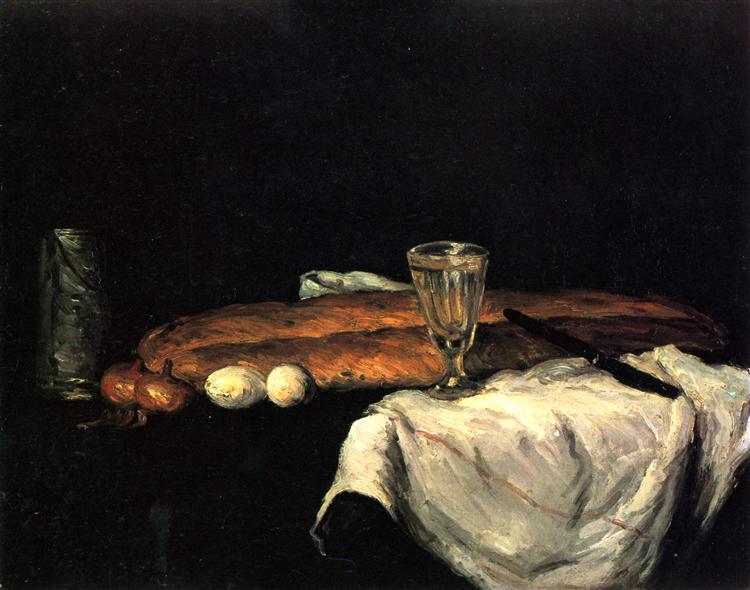Tanım
Paul Cézanne's Still Life with Bread and Eggs (1865) is part of a decisive period in his career, when the artist began to emerge as his own voice within the Post-Impressionism movement. In this painting, Cézanne offers us a meticulous exploration of composition and colour, as well as a reflection on the nature of the object and its artistic representation.
At first glance, the work appears as a classic still life, a subject in which Cézanne excelled. The composition is simple but profound, centered on a plate with nuts and eggs, a piece of bread and a jug, all placed on a table against a background of soft tones. This background, which features a subtle gradation of colors ranging from grayish to earthy, acts as a contrast that enhances the elements in the foreground. The objects are arranged in a way that suggests both stability and dynamism, challenging the traditional perception of perspective.
Known for his experimentation with form and colour, Cézanne uses a limited but effective palette in this work, encompassing soft yellows, earthy browns and greys, evoking a warmth and naturalness that are characteristic of his style. The juxtaposition of the crusty bread and bright eggs against the duller background not only highlights the functionality of the still life, but also invites the viewer to reflect on everyday life and the fragility of the ephemeral.
One of the most intriguing aspects of the work is the technique Cézanne employs to create volume and depth. He uses constructed brushstrokes, evident in his treatment of the bread and eggs, which seem to come to life through subtleties of light and shadow. This form of painting is considered a precursor to Cubism, where the object is not a mere landscape, but an entity whose complexity is manifested through the interplay of planes and colors.
The fact that there are no human characters in the scene does not detract from the work. On the contrary, the absence of human figures allows the viewer to focus on the intricate relationship between objects, an exploration that Cézanne pursues throughout his career. The choice of a subject as seemingly mundane as bread and eggs becomes a vehicle for discourse on perception, representation and sensory experience.
"Still Life with Bread and Eggs" is an outstanding example not only of Cézanne's talent, but also of his influence on future generations of artists. By breaking down the elements of nature, he invited artists to observe and represent their surroundings in a more introspective and personal way. Similar works, such as "Still Life with Apples and Oranges" or "The Card Players", continue in this line of approaches that explore space and form in a constant dialogue with color and light.
In conclusion, this work by Cézanne is not simply a representation of inanimate objects, but a reflection on reality, perception and human experience. "Still Life with Bread and Eggs" is a testament to the ingenuity of an artist who, through the simplicity of his subject, manages to delve into the complexities of existence. Like so many other works by Cézanne, it is a call to rediscover the everyday, highlighting its intrinsic beauty.
KUADROS ©, a famous painting on your wall.
Hand-made oil painting reproductions, with the quality of professional artists and the distinctive seal of KUADROS ©.
Painting reproduction service with satisfaction guarantee. If you are not completely satisfied with the replica of your painting, we will refund 100% of your money.

